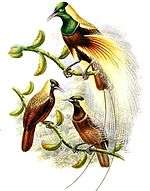Emperor bird-of-paradise
| Emperor bird-of-paradise | |
|---|---|
| | |
| Male in display posture (taxidermy mount) | |
| Scientific classification | |
| Kingdom: | Animalia |
| Phylum: | Chordata |
| Class: | Aves |
| Order: | Passeriformes |
| Family: | Paradisaeidae |
| Genus: | Paradisaea |
| Species: | P. guilielmi |
| Binomial name | |
| Paradisaea guilielmi Cabanis, 1888 | |
The emperor bird-of-paradise (Paradisaea guilielmi), also known as emperor of Germany's bird-of-paradise is a species of bird-of-paradise.
The emperor bird-of-paradise is endemic to Papua New Guinea. It is distributed in hill forests of the Huon Peninsula. The diet consists mainly of fruits, figs and arthropods.
The name commemorates the last German Emperor and King of Prussia, Wilhelm II of Germany. In January 1888, the emperor bird-of-paradise was the last bird-of-paradise discovered by Carl Hunstein, who also found the blue bird-of-paradise on his journeys. These two species, along with the red bird-of-paradise, are the only Paradisaea that perform inverted display.
Due to ongoing habitat loss, limited range and overhunting in some areas, the emperor bird-of-paradise is evaluated as Near Threatened on the IUCN Red List of Threatened Species. It is listed on Appendix II of CITES.
Description

The emperor bird-of-paradise is large, approximately 33 cm long, yellow and brown with a reddish-brown iris, bluish-grey bill and purplish-brown legs. The male has an extensive dark emerald green face and throat, two very long tail wires and large white ornamental flank plumes. The female is almost similar to the male, but has an all brown plumage, smaller in size and has no ornamental plumes.
References
- ↑ BirdLife International (2012). "Paradisaea guilielmi". IUCN Red List of Threatened Species. Version 2013.2. International Union for Conservation of Nature. Retrieved 26 November 2013.
External links
| Wikimedia Commons has media related to Paradisaea guilielmi. |
| Wikispecies has information related to: Paradisaea guilielmi |
